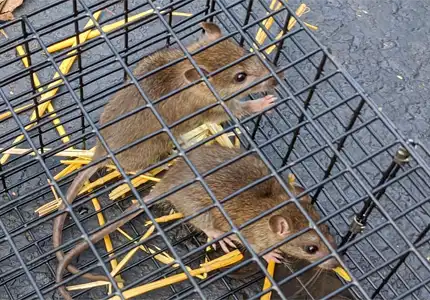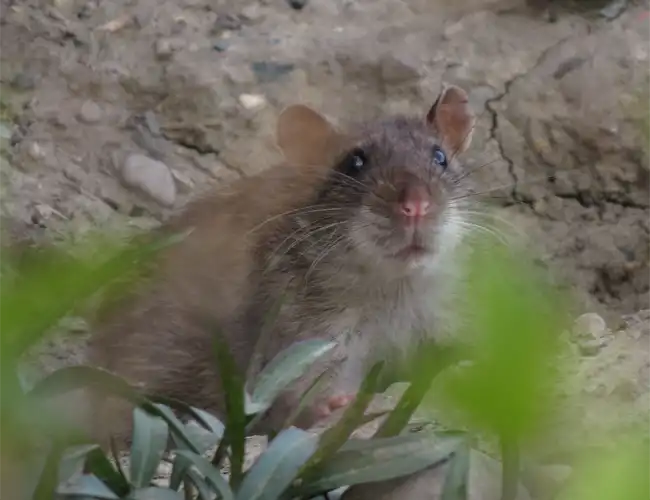
Rats in Virginia

Quick Rat Information
Species in Virginia: 6
Common Locations: Clutter, Walls, Attic, Behind Furniture
Damages: Insulation, Wood, Wires
Health Concerns: Rat-bite fever, Salmonellosis, Hantavirus
Rats in Virginia:
A Detailed Guide to the Species
Rats are a common presence in Virginia, and they play a significant role in the ecosystem. These mammals are important as both predators and prey, and their activities can have a profound impact on the environment. Rats have a long history in Virginia, having been introduced to the state by European colonizers in the early 17th century. Since then, they have spread throughout the state, adapting to various habitats and ecosystems.
Today, several species of rats can be found in Virginia, each with unique characteristics and behaviors. These rats play important ecological roles, such as dispersing seeds and controlling insect populations. However, rats also pose significant public health concerns, as they can carry and transmit diseases to humans and other animals.
Species of Rats in Virginia

Roof Rat
Rattus rattus
Roof rats, also known as black rats, are found in Virginia’s urban and suburban areas. They nest in high places like attics and have a slender, agile body with a pointed snout, large ears, and a long, scaly tail. Their fur ranges from black to gray or brown and they can grow up to 18 inches in length.
Roof rats are social, active mainly at night, and have keen senses. They live in colonies, feed on fruits, vegetables, nuts, seeds, and insects, and are considered omnivores.

Norway Rat
Rattus norvegicus
Norway rats, also known as brown rats, are a common rodent species found throughout Virginia. They have a robust, heavy body with brown fur, small ears, and a short, scaly tail. They can grow up to 16 inches in length and are usually found in sewers, basements, and other damp places.
Norway rats are also social animals and are known to live in large colonies. They are omnivores and feed on a variety of food sources, including grains, fruits, and vegetables. They are nocturnal and have a keen sense of smell, which helps them locate food and avoid danger.

Allegheny Woodrat
Neotoma magister
The Allegheny Woodrat, also known as the Eastern Woodrat, is a small rodent species found in the Appalachian Mountains of Virginia. They have a brownish-gray fur coat, large ears, and a long, bushy tail. They are primarily active at night and are known for their characteristic habit of collecting and storing various objects in their dens.
They are herbivores and feed on a variety of plant material such as leaves, bark, and fruits. They are solitary animals and are most commonly found in rocky habitats such as cliffs, boulder fields, and rock outcrops. Due to habitat loss, the population of them in Virginia has significantly declined in recent years.
Life Cycle of Rats
Reproduction and Development
Rats are prolific breeders and can produce several litters in a single year. The Norway rat and roof rat have a gestation period of about 21-23 days and can produce litters of 7-14 young per litter.
Rats can breed year-round, but the breeding season is typically from early spring to late fall. Young rats are born blind and hairless and are dependent on their mother’s milk for the first few weeks of life.
Lifespan and Mortality
The lifespan of rats varies depending on the species and environment. Norway rats typically live for 1-2 years in the wild, while roof rats and house mice can live up to 3 years. However, in captivity, rats can live up to 4-5 years.
Rats face many threats to their survival, including predation, disease, and human intervention. Predators of rats include birds of prey, snakes, and domestic cats and dogs. Rats can also contract diseases from other rats or contaminated food and water sources. Additionally, humans may use various control methods, such as poisons and traps, to reduce rat populations.
Habitat and Environmental Requirements
Rats have adapted to a wide range of environments and can thrive in both natural and urban settings. They are commonly found in fields, forests, and wetlands, as well as in human-made structures such as homes, warehouses, and sewers. Rats require access to water and food sources to survive, and they prefer areas with adequate shelter and protection from predators.
Feeding Habits and Diets
Rats are omnivorous and will eat almost anything, including fruits, vegetables, grains, meat, and even garbage. They have strong teeth that can gnaw through tough materials, such as wood and concrete, which allows them to access a variety of food sources. Rats are also known to hoard food in their burrows or nests, which can create sanitation issues and attract other pests.
Social Behaviors
Rats are social animals that live in groups or colonies. Norway rats and roof rats typically form hierarchical social structures, with dominant rats controlling access to resources and breeding opportunities. House mice also exhibit social behaviors and will form close-knit family groups. However, rats are also known to be aggressive towards each other and may fight over resources or territory.

Diseases Transmitted by Rats
Rat Diseases in Virginia
Hantavirus is a rare but potentially deadly disease, and it is important to take precautions when dealing with rodents to prevent exposure to the virus.
Leptospirosis is a bacterial disease that can be transmitted to humans through contact with the urine of infected rodents, including rats. The bacteria can enter the body through cuts, abrasions, or mucous membranes, and can cause a range of symptoms from mild flu-like illness to more severe complications such as kidney and liver failure. Leptospirosis is a rare but potentially serious disease, and it is important to take precautions when dealing with rodents to prevent exposure to the bacteria.
Plague is a bacterial disease that is primarily spread through the bites of infected fleas that live on rodents, including rats. The disease can also be transmitted through contact with infected animals, such as rats or their fleas, or through inhalation of respiratory droplets from infected animals or humans. Plague can cause a range of symptoms in humans, from flu-like illness to more severe forms such as bubonic, septicemic, or pneumonic plague.
While rare, plague can be a serious and potentially deadly disease if left untreated. Early diagnosis and treatment with antibiotics are crucial for successful recovery from plague.
Rat-bite fever is a rare bacterial infection that can be transmitted to humans through bites, scratches, or contact with the urine or feces of infected rodents, including rats. The symptoms of rat-bite fever can vary and may include fever, vomiting, muscle pain, and rash. The infection can be treated with antibiotics, but if left untreated, it can lead to serious complications, such as sepsis and meningitis.
Rat-bite fever is relatively uncommon in the United States, but it can occur in individuals who come into contact with infected rodents, including pet rats. It is important to take precautions when handling rodents and to seek medical attention if you experience symptoms of rat-bite fever.
Salmonellosis is a bacterial infection caused by Salmonella bacteria, which can be transmitted to humans through contact with contaminated food or water, as well as through contact with infected animals, including rats. Symptoms of salmonellosis typically include fever, diarrhea, and abdominal pain, and the infection can be severe in individuals with weakened immune systems, older adults, and young children.
While salmonellosis can be treated with antibiotics, prevention is key to avoiding infection. This includes practicing proper food hygiene and washing hands thoroughly after handling rats or their droppings.
Trichinosis is a disease caused by a parasitic roundworm called Trichinella spiralis. This parasite is commonly found in carnivorous animals such as rats and pigs, and humans can contract the disease by consuming undercooked or raw meat from infected animals. The symptoms of trichinosis can range from mild to severe, with initial symptoms including nausea, vomiting, diarrhea, and abdominal pain. As the infection progresses, symptoms such as muscle pain, weakness, fever, and swelling around the eyes can occur. In severe cases, the infection can lead to heart and lung problems, and in rare cases, even death.
Treatment for trichinosis typically involves medication to kill the parasites and manage symptoms, but early diagnosis is key for successful treatment.
Tularemia, also known as rabbit fever, is a disease caused by the bacterium Francisella tularensis. It is commonly transmitted to humans through the bite of infected ticks or deer flies, handling of infected animals, or through contaminated food or water. In Virginia, tularemia is commonly associated with rabbits and other small rodents such as squirrels and mice.
Symptoms of tularemia can vary depending on the method of transmission, but often include sudden onset of fever, chills, headaches, muscle aches, and fatigue. Other symptoms may include skin ulcers or swollen lymph nodes, depending on the site of infection. If left untreated, tularemia can lead to severe illness or even death in rare cases.
Typhus is a disease caused by bacteria that are transmitted to humans through the bites of fleas, lice, or mites that have been infected with the bacteria. In Virginia, typhus is most commonly associated with the rat flea, which can carry the bacteria that causes the disease. Symptoms of typhus can include fever, headache, muscle pain, and a rash. Without proper treatment, typhus can lead to more severe complications, such as pneumonia or kidney failure. In order to prevent typhus, it is important to take measures to control rat populations and to avoid contact with fleas, lice, or mites that may be carrying the bacteria.
If you suspect that you or someone you know may have been infected with typhus, seek medical attention as soon as possible.
Health Concerns
Rats pose a significant public health concern in Virginia and across the United States. The presence of rats in and around homes and businesses can increase the risk of disease transmission and create unsanitary conditions. Additionally, rats can cause damage to property and infrastructure, which can lead to additional health and safety hazards.
Preventing and controlling rat infestations is essential for protecting public health. Individuals can take several preventative measures, such as storing food and waste in secure containers, sealing gaps and holes in buildings, and keeping outdoor areas clean and free of clutter. Additionally, professional pest control services can provide targeted and effective methods for eliminating rat populations.
Conclusion
In conclusion, rats are an important part of Virginia’s ecosystem, but they can also pose significant health and safety risks when they invade homes and businesses. There are several species of rats in Virginia, each with its own habitat preferences and behaviors. Understanding the life cycle, ecology, and behavior of rats is essential for effective control and management.
Rats can transmit several diseases to humans and other animals, making them a significant public health concern. Preventing and controlling rat infestations requires a comprehensive approach, including preventative measures and targeted control methods. Effective rat control and management can help protect public health and safety, prevent property damage, and promote healthy environments for people and wildlife alike.
Professional pest control services can provide targeted and effective methods for eliminating rat populations, and government agencies play an essential role in promoting rat control and management efforts. By working together, individuals, pest control professionals, and government agencies can help prevent and control rat infestations in Virginia and promote a healthy and safe environment for all.

Do You Have a Rat Problem?
Learn more about our Rat Removal Program or call us at (540) 776-1769

